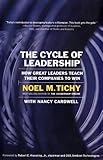The Cycle of Leadership: How Great Leaders Teach Their Companies to Win
In The Leadership Engine, Noel Tichy showed how great companies strive to create leaders at all levels of the organization, and how those leaders actively develop future generations of leaders. In this new book, he takes the theme further, showing how great companies and their leaders develop their business knowledge into “teachable points of view,” spend a great portion of their time giving their learnings to others, sharing best practices, and how they in turn learn and receive business ideas/knowledge from the employees they are teaching. Calling this exchange a virtuous teaching cycle, Professor Tichy shows how business builders from Jack Welch at GE to Joe Liemandt at Trilogy create organizations that foster this knowledge exchange and how their efforts result in smarter, more agile companies, and winning results. Some of these ideas were showcased in Tichy’s recent Harvard Business Review article entitled, “No Ordinary Boot Camp.” Using examples from GE, Ford, Dell, Southwest Air
List Price: $ 26.95
Price: $ 1.99
Check This:
 Statistics for Six Sigma Made Easy
Statistics for Six Sigma Made EasyThe first plain-English guide to solving real-world problems with Six Sigma So you’re ready to improve your processes and p…
 The Six Sigma Black Belt Handbook (Six SIGMA Operational Methods)
The Six Sigma Black Belt Handbook (Six SIGMA Operational Methods)EXTREME SIX SIGMA:A new series that takes Six Sigma to the next level The Six Sigma Operational Methods Series goes beyond simply …
 The Six Sigma Handbook, Third Edition
The Six Sigma Handbook, Third EditionThe authoritative classic–revised and updated for today’s Six Sigma practitioners Whether you want to further your Six Sig…
Related Six Sigma Black Belt Products



A New “Business Classic”,
Those who are familiar with my reviews of other business books already know that on several dozen occasions, I have strongly recommended The Leadership Engine (1997) which Tichy wrote with Eli Cohen and Nancy Cardwell. He teams up with her again in this book, expanding and enriching his concept of leadership development at all levels throughout any organization, regardless of its size or nature. Hence the importance of what Tichy calls a “Virtuous Teaching Cycle”: Everybody teaches and everybody learns; all practices, processes, and values promotion teaching; all teaching is interactive to generate the effective exchange of knowledge; thereby, maximum use is made of everyone’s skills and talents to ensure all-level alignment for smart and rapid response to needs, problems, opportunities, etc. Tichy asserts (and I agree) that hypertransformation (in established organizations) and hypergrowth (in start-ups) are essential to business success. The challenge in established organizations is to overcome what Jim O’Toole characterizes as “the ideology of comfort and the tyranny of custom.” For start-ups, the challenge is to achieve appropriate scale while ensuring that new employees are brought on line and up to speed ASAP. In ten chapters, and with prevision as well as eloquence, Tichy explains how various organizations (notably GE) have met those and other challenges.
Unlike other authors who address many of the same issues, Tichy also includes a substantial Handbook (pages 285-394) which consists of ten Sections: The Teaching Organization, The Hand You have Been Dealt, Building Your Teachable Point of View, Pulling It All Together, Building a Team Timetable Point of View, Architecting the Leadership Pipeline, Scaling the Teaching Organization, Building Teaching into the DNA, Global Citizenship, and finally, Start the Journey. In the Handbook, Tichy explains provides decision-makers with with just about everything their need to know to design, implement, and then strengthen their own Teaching Organization, one within which the Virtuous Teaching Cycle sustains leadership development at all levels.
In his Introduction to the Handbook, Tichy quotes a brief statement from Thomas Stewart’s most recent book, The Wealth of Knowledge:
“The knowledge economy stands on three pillars. The first: Knowledge has become what we buy, sell, and do. It is the most important factor of production. The second pillar is a mate, a corollary to the first: Knowledge assets — that is, intellectual capital — have become more important to companies than financial and physical assets. The third pillar is this: To prosper in this new economy and exploit these newly vital assets, we need new vocabularies, new management techniques, and new strategies. On these three pillars rest all the new economy’s laws and its profits.”
Tichy includes this brief statement because it is directly relevant to his own objectives in The Cycle of Leadership but also because, unless and until an organizations has all three pillars (not one, not two but all three), it cannot survive major challenges which await them, many of which have yet to be revealed. That is to say, the Teaching Organization can only be built on the foundation they provide.
“Winning leaders are teachers, and winning organizations do encourage and reward teaching. But there is more to it than that. Winning organizations are explicitly designed to be Teaching Organizations, with business processes, organizational structures, and day-to-day operating mechanisms all built to promote teaching.” However, Tichy doesn’t stop there. More importantly, the teaching that takes place is a distinctive kind of teaching. It is interactive, two-way, even multi-way. Throughout the organization, `teachers’ and `students’ at all levels teach and learn from each other, and their interactions create a Virtuous Teaching Cycle that keeps generating more learning, more teaching, and the creation of new knowledge.”
Those who share my high regard for this book are urged to check out Peter M. Senge’s The Fifth Discipline: The Art and Practice of the Learning Organization (1990) and The Dance of Change: The Challenges of Sustaining Momentum in Learning Organizations (1999), William Isaacs’ Dialogue and the Art of Thinking Together: A Pioneering Approach to Communicating in Business and in Life (1999), Carla O’Dell’s If Only We Knew What We Know: The Transfer of Internal Knowledge and Best Practice (1998), and Thomas H. Davenport and Laurence Prusak’s Working Knowledge: How Organizations Manage What They Know (1997).
Was this review helpful to you?

|